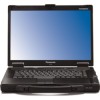Panasonic Toughbook 52 Assessing the Broad Business Case for Rugged Computing - Page 6
schematics and technical specifications to solve problems or upgrade - semi rugged laptop
 |
View all Panasonic Toughbook 52 manuals
Add to My Manuals
Save this manual to your list of manuals |
Page 6 highlights
Assessing The Broad Business Case For Rugged Computing From a practical end-user standpoint, enterprise notebooks can be broken down into three basic categories: ...Rugged (also known as Fully-Rugged) Laptop Computers These are computers that must withstand the harshest environmental conditions, including dust, sand, lots of shock and vibration (such as in vehicle- mounted applications), as well as situations that can lead to a device falling to the deck or ground. The most dramatic examples of this environment are the front-lines of a combat situation or in public safety applications. Other examples include construction sites, oil rigs, field service applications and other conditions that expose the device to outdoor elements and harsh treatment. ...Semi- and Business-Rugged (also known as Durable) Laptop Computers This tier applies to a wide array of conditions that may expose a mission-critical device (that contains applications and data that are crucial to maintaining business operations and employee productivity) to damage or failure. From a market development perspective, this is the high-growth segment of the rugged market. Examples of people in need of business-rugged capabilities include (but are not limited to): • Consultants and other business executives who carry their entire "office" with them during engagements. These engagements often call for extended visits with clients at their location. Even during extensive periods of travel they must continue to manage their day-to-day business operations as they deliver value to their clients. • Outside sales people who travel often to meet with clients to present proposals and presentations as well as access data and keep track of transactions that must be synchronized with back office systems at headquarters. • Field engineers or architects who work at client or job sites and carry schematics and technical specifications to solve problems or upgrade systems for clients that are geographically dispersed. • Healthcare professionals who carry patient and clinical information. This includes doctors, therapists, nurses and physician assistants providing routine care in hospitals, clinics and homecare situations. (Emergency medical and operating room scenarios will find more appropriate solutions in the "rugged computing" category.) ...Non-Rugged (also known as commercial or consumer) Laptop Computers These are for applications that require the lowest level of ruggedness. This solution works for organizations that have made a decision to replace all desk-top computers with laptops or notebooks, for users, including administrative personnel, who are not likely to travel or expose their devices to harsh conditions, as their laptops rarely leave the office environment. Copyright © All Rights Reserved for Larstan Business Reports 6














